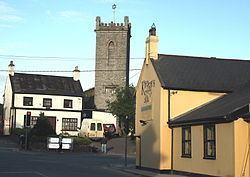Irish Grid Reference N872278 Elevation 70 m Local time Monday 12:05 PM | Website www.clane.ie Population 6,702 (2011) | |
 | ||
Weather 7°C, Wind SW at 10 km/h, 82% Humidity | ||
Road trip from clane co kildare to allenwood co offaly
Founded in 520 A.D; Clane (Irish: Claonadh) is a town in County Kildare, Ireland, 35.4 km (22 mi) from Dublin. Its population of 6,702 makes it the eighth largest town in Kildare and the 78th largest in Ireland. It is on the River Liffey. Clane gives its name to the associated townland, civil parish, electoral division and barony.
Contents
- Road trip from clane co kildare to allenwood co offaly
- Map of Clane Co Kildare Ireland
- St patrick s day highlights clane 2013
- History
- Features
- Places of interest
- Clane today
- Transport
- Sport
- Education
- Shopping
- Food drink
- Religion
- Language
- Clane in fiction
- People
- References
Map of Clane, Co. Kildare, Ireland
St patrick s day highlights clane 2013
History
Clane is located on the crossroads of the R403 and R407 regional roads, halfway between Maynooth and Naas in north Kildare.
The town most probably owes its origin to the foundation of an abbey in the sixth century, from about 520 A.D., when Ailbe of Emly, Bishop of Ferns, founded an Abbey in Clane, and made St. Senchel the Elder its first Abbot. Saint Ultan Tua, who used to put a stone into his mouth to prevent him from speaking during Lent, and his brother Fotharnaise, are said to have been buried in Clane. They were brothers of Maighend, Abbot of Kilmainham, from whom the parish and church of Mainham, near Clane, were probably called. King Mesgegra's Mound claims links to the legendary first-century AD king Mesgegra of Leinster and was later used by Normans.
The ruins of the Franciscan monastery founded at Clane by Sir Gerald FitzMaurice, 3rd Lord Ophaly, in 1272 still exist. In 1542 Henry VIII’s Commissioner granted the site and precincts of this House of Friars, manor or preaching-house of the preaching Friars of Clane to Robert Eustace, Roger Roche and Ed. Brown for £177. Besides about 70 acres (28 ha) of land in the neighbourhood - its possessions consisted of a church, cemetery, chapter-house, dormitory, store, kitchen, two chambers, stable and orchard. The dormitory and other buildings probably stood on the north side of the Abbey Church, and have long since completely disappeared.
The parish of Clane has the distinction of being the place where the rebellion of 1798 broke out; a battle between the United Irishmen and the Yeomen forces led by Richard Griffith took place on Coiseanna Hill by the modern Woods Centre. The rebels were easily defeated, and the survivors fled to Timahoe with the rest of the North Kildare rebels.
Features
Clane has two Liffey tributaries, the Butter Stream at the south west, with a small park, and the Gollymochy River at the eastern side.
Places of interest
Clane today
In recent decades Clane has developed as a dormitory town for Dublin which lies 32 km (20 mi) to the east. Outside of rush hour times the capital can be reached in 30 minutes.
Transport
A commuter railway station in Sallins, some 6 km (4 mi) from Clane, has a regular service to Dublin. The town is also served by Bus Éireann, which operates regular bus service between Edenderry and Dublin. A rapid town link service, provided by private operator J.J. Kavanagh and Sons operates hourly between Clane, Sallins and Naas, while a route to NUI Maynooth served by the same company operates on weekdays.
Sport
Education
Shopping
The town is a destination for residents of smaller areas located around Clane, boasting several stores such as Aldi, Lidl, Tesco Metro and one of Ireland's largest SuperValu stores. Other smaller stores in the town include a Londis and a Centra for convenience.
Food & drink
Clane is home to several pubs, restaurants and cafes. There are five bars in the town, including the GAA club and the Oak Bar at the Westgrove Hotel. Popular restaurants include Zest restaurant and cafe, the Assagio restaurant at the Westgrove Hotel, Bombay Bistro, the Lemongrass, the Pot and Pantry and O'Briens.
Religion
Saint Patrick's & Saint Brigid's Church is the Catholic place of worship, part of the Catholic parish of Clane and Rathcoffey. It first opened in 1884, and was renovated after a fire in 2008, which left the church unsafe. The local Church of Ireland church is Church of St Michael and All Angels, Millicent (C of I parish of Clane and Donadea), a 19th-century building noted for its architecture and interior.
Language
Clane in fiction
The town of Clane is one of the settings in the early life of Stephen Daedalus, the protagonist in James Joyce's novel, A Portrait of the Artist as a Young Man.
